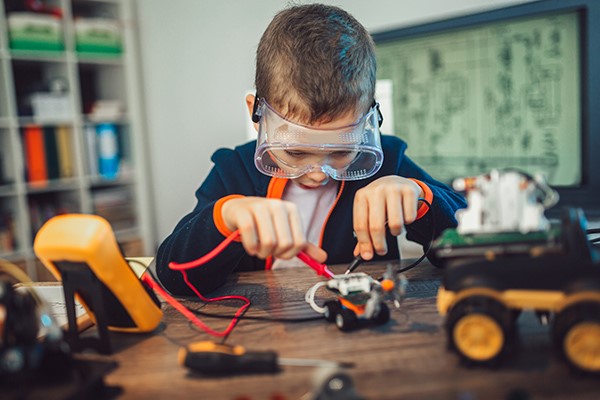Newsletter vol.8 STEAMカリキュラムとテクノロジーと現代教育
ライアン・キャロル
教育の政策立案者は、21世紀の労働市場で成功するイノベータ―になるために必要なスキルと知識を生徒に身に付けるための戦略を模索している。特に重要とされているのは、科学(Science)・技術(Technology)・工学(Engineering)・芸術(Arts)・数学(Mathematic)の5つの分野に学生を関与させるSTEAM教育である。STEAMとは、従来のSTEMにアートを組み込んだものであり、大まかに言えば、工学と技術をイマジネーション豊かなデザインと統合し、ある問題に対する創造的な解決策を生み出すことを推奨する。単に難しい方程式を解くのではなく、そこにアートやクリエイティブの要素を追加することで、より魅力的なカリキュラムになるというメリットがある。STEAMは,その中核となるSTEMのフレームワークを損なわずに、アートを追加することで、生徒たちの想像力を刺激し、コーディングや3Dキャラクターデザイン等を通してSTEM教育の実践に繋げることができると考えられている。[1]
米国および世界の多くの教育専門家は、STEAMを21世紀の教育に不可欠な要素と考えている。米国教育省によれば「絶え間なく変化し、ますます複雑化する世界においては、我々の国の若者が、問題解決・情報理解・エビデンスの収集と評価するなどの知識とスキルを習得する事が、これまで以上に重要になっている」という。[2] また、米国労働統計局は「STEM/STEAM分野の雇用は2018年から2028年までの間に8.8%増加する」と予測している。[3] この労働市場ニーズの対応策として、米国教育省は学区ごとにカリキュラムを強化できるよう年間数百万ドルの助成金を交付し,生徒たちは従来の画材の枠を超えた、3Dプリンターやハイテク機材を頻繁に使ってSTEAM教育を受けることができる。STEAM教育は単にアートを追加するだけでなく、生徒一人ひとりが自分のやり方に応じて、より高度なデザインとエンジニアリングの能力開発を強化している。
米国で支援が十分ではない学区では、STEAM教育を促進するために、非営利団体等が移動教室やモバイル・ラボを立上げ、STEMの授業に参加する機会がない生徒に提供している。この場に集う多くの生徒たちは、3Dプリンターやロボット工学、フライトシミュレータや拡張現実などの高度な技術を初めて体験できる。[4] 5Gの出現により教室での拡張現実(AR)と仮想現実(VR)を利用できる。AR/VRは、天文学など非常に視覚的に捉えづらい概念を理解することや、建築科の学生が構造上の理解を深める助けにもなっている。[5]
5Gなどの新技術により、今日の教室では高解像ビデオを通じた共同作業、最新のデジタルワークプレイスの用意、自分のペースで学習するためのリソースへの継続的なアクセスなど、革新的な機能が多く利用できるようになる。これらのツールは、教室でのSTEAM教育を拡張し、それにより生徒が継続的に進化し、最新のテクノロジーを活用できるようになる。適切な環境でSTEAM教育を受けた若者は、今後の労働市場においてますます重要となるスキル(計算的思考、コーディング、ロボット工学など)を必然的に身に付けることになる。ただし、この方針を維持するには、地域社会の技術及びビジネスコミュニティによる草の根レベルでの継続的な投資とともに、政府の施策及び資金分配による投資も必要である。
STEAM Curriculum, Technology, & Modern Education
Ryan Carroll
Policymakers in education are exploring strategies to equip students with the skills and knowledge required to be successful innovators in the 21st century workforce. An important outcome of this is STEAM, an educational discipline that engages students around the subjects of Science, Technology, Engineering, the Arts and Math. STEAM incorporates STEM subjects with Arts into various relevant education disciplines. At a high level, STEAM encourages students to integrate engineering and technology with imaginative designing, to produce creative solutions to problems. The addition of Arts into the equation has the added benefit of making the curriculum more appealing to young children. Rather than detracting from the core STEM framework, the addition of Arts can spark students’ imagination and help them innovate through hands-on STEM projects, whether that’s coding or 3D character design.[1]
Many education experts, both in the United States and globally, consider STEAM an essential piece of 21st century education. According to the U.S. Department of Education, “In an ever-changing, increasingly complex world, it’s more important than ever that our nation’s youth are prepared to bring knowledge and skills to solve problems, make sense of information, and know how to gather and evaluate evidence to make decisions.”[2] And the U.S. Bureau of Labor Statistics states that jobs in the STEM/STEAM fields will increase by 8.8 percent between 2018-2028.[3] In order to prepare its workforce for these jobs, the U.S. Department of Education issues millions of dollars in annual grants to help school districts enhance their curriculum accordingly. Students learning with STEAM frequently use 3D printers and other high-tech “maker” materials outside the scope of traditional art supplies. Rather than simply adding art, this education system empowers students to develop high-order design and engineering skills while allowing them to innovate in an individualistic manner.

Source: San Diego Family Magazine
To promote STEAM education in underserved school districts in the United States, certain nonprofit organizations have launched portable classrooms or “mobile labs” that bring science, technology, engineering, and math activities to students who might not otherwise have the opportunity to participate in these lessons. The mobile labs are often the students’ first exposure to advanced technologies such as 3D printing, robotics, flight simulators, and augmented reality.[4] The emergence of 5G wireless networks, and the low-latency connectivity and broad coverage they enable, have allowed classrooms to taking advantage of augmented reality (AR) and virtual reality (VR). AR/VR supplements the STEAM curriculum in meaningful ways by helping students grasp difficult concepts in highly visual subjects such as astronomy. Another example is architecture students using VR to explore 3D renderings of structures to help comprehend the impact of various design decisions.[5]
New technologies such as 5G allow for a whole host of revolutionary capabilities in today’s classroom, including real life collaboration in high-definition video, modern digital workplace preparation, and continuous access to resources for self-paced learning. These tools enhance the STEAM curriculum in the classroom setting, allowing students to continually evolve and take advantage of these modern technologies. Young learners exposed to a STEAM curriculum within the proper setting will inevitably develop the skills that are becoming increasingly important to today’s employers. Such skills include computational thinking, coding, and robotics, among others. However, in order to maintain this trajectory, there needs to be continues investment both at the grassroots level by the local tech and business community, as well as through government policy and funding allocations.
[1] “STEAM Rising: Why we need to put the arts into STEM education,” Accessed 3.6.23, https://slate.com/technology/2015/06/steam-vs-stem-why-we-need-to-put-the-arts-into-stem-education.html
[2] “Science, Technology, Engineering, and Math, including Computer Science,” Accessed 3.6.23, https://www.ed.gov/stem
[3] “It’s Full S.T.E.A.M. Ahead with These Five Education Grants,” Accessed 3.6.23. https://www.grantwatch.com/grantnews/its-full-steam-ahead-with-these-five-education-grants/
[4] “Bringing STEM to Students with Mobile Technology,” Accessed 3.6.23, https://edtechmagazine.com/k12/article/2021/09/bringing-stem-students-mobile-technology
[5] “Why fast, reliable internet is a requirement for higher education,” Accessed 3.6.23, https://www.t-mobile.com/business/resources/articles/access-to-technology-higher-education
Ryan Carroll
Ryan Carroll works as a Regional Sales Manager covering the Pacific Northwest, USA for Ericsson. Here, he focuses on their Cradlepoint solution, which is cloud-managed wireless edge networking equipment. Prior to this role, he worked for T-Mobile in Bellevue, Washington where he specialized in telecommunications and IoT solutions for government agencies and nonprofit institutions. Ryan has also worked in sales at AT&T, leading the company’s efforts in Washington and Idaho and managing numerous wireless projects like distributed antenna systems, private networking solutions, and traditional mobility. Ryan attended the University of Chicago as an undergraduate and then earned his Master’s Degree in German and International Business at Georgetown University, where he wrote his thesis on the European Union’s telecommunications and aviation market. He currently lives in Seattle with his wife, son, and dog.
Ryan Carroll氏は、エリクソンの米国太平洋岸北西部を担当する地域セールスマネージャーとして働いています。ここでは、クラウド管理のワイヤレスエッジネットワーキング機器である Cradlepoint ソリューションに焦点を当てています。前職は、ワシントン州ベルビューの T-Mobile に勤務し、政府機関や非営利機関向けの電気通信および IoT ソリューションを専門としていました。以前は AT&T のセールス部門にも従事し、ワシントンとアイダホでの同社の取り組みを主導し、分散型アンテナ システム、プライベートネットワーキングソリューション、従来のモビリティなどの多数のワイヤレス プロジェクトを管理しました。シカゴ大学に学部生として出席し、ジョージタウン大学でドイツ語および国際ビジネスの修士号を取得、欧州連合の電気通信および航空市場に関する論文を書きました。彼は現在、妻、息子、犬と一緒にシアトルに住んでいます。

